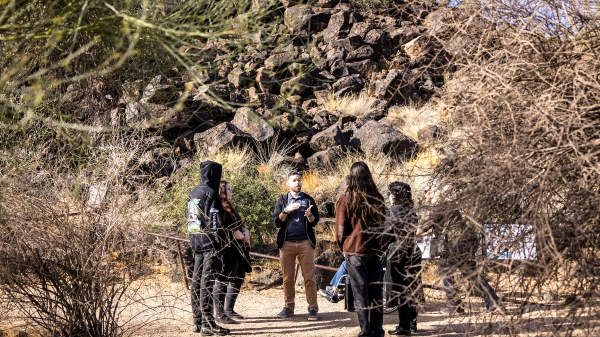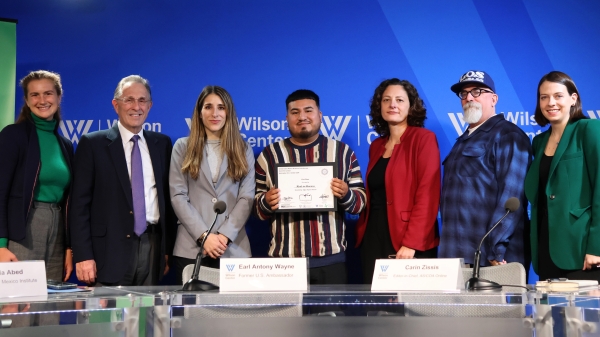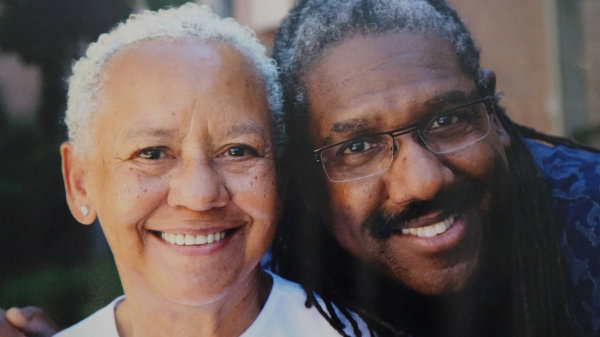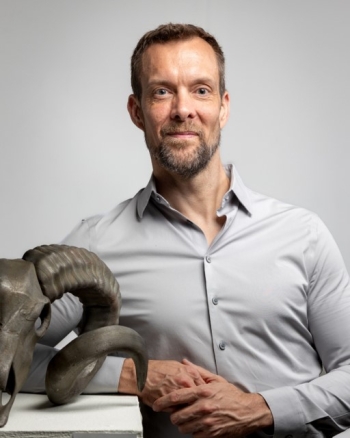Editor’s note: This story is part of a series of profiles of notable fall 2023 graduates.
Bruce Ward is from a small town of 940 people in western Oregon, where he graduated from high school in 1998. Three years later, Ward enlisted in the United States Marine Corps, serving from 2001 to 2006 as an air traffic control communications technician.
In 2006, he moved to Gilbert, Arizona, to work in the aeronautics industry — but then was incarcerated in 2009. After serving 11 years, Ward was released on August 11, 2020, and began his education at ASU only nine days later. Now, he is set to graduate this fall with a BFA in sculpture, a minor in architectural studies, and aspirations to begin his MFA soon after.
Encouraging 'creativity in confinement'
While incarcerated, Ward became involved with the ASU Center for Correctional Solutions (CSS), whose stated goal is to “create a just and fair approach to corrections that repairs harm, empowers people, and promotes public safety.” Ward first began working with CSS when he donated a painting to an ASU charity show called “Inkarcerated,” a show designed to highlight creativity in confinement and raise money for a local charity that aims to reduce recidivism.
In 2017, Ward participated in the Inside-Out Prison Exchange Program (interview with Ward begins at 5:33). This program is a course offered to ASU students (outside students) and incarcerated students (inside students) that aims to humanize incarcerated individuals in the eyes of ASU’s criminal justice students and gives those incarcerated the chance to begin their higher education journey while serving time.
“The Inside Out Program really challenged me, and I started to realize that I could go to college, I could go to ASU ... and I didn’t think that was a possibility for me before I took the class,” Ward said.
Once Ward was released from incarceration, he began to promote the Inside-Out Program as an ASU student and curated both the third and fourth annual "Inkarcerated" shows. These shows give incarcerated artists the opportunity to engage with the community and raise money for the CSS scholarship, which serves justice-impacted learners.
In addition, his work as a curator promotes art programs at several Arizona prison yards while simultaneously allowing incarcerated artists a charitable connection to the community. Ward currently serves as a peer-mentor to individuals returning from incarceration, and he plans to continue encouraging creativity in confinement via his graduate studies. Ultimately, Ward said he would like to continue facilitating the Inside-Out Program and help others transition successfully back into society.
“Bruce Ward embodies a compelling story of self-transformation through art and education,” said School of Art Associate Professor Hilary Harp. “When I met Bruce as a student in my Sculpture II class, I was not aware of this story. I only knew that Bruce was a serious artist and an excellent student. It was immediately apparent that Bruce recognized the power of art to speak and reach people, and he took responsibility for the message in all of his work. I don’t believe I’ve worked with a student who more fully embodies both the ASU Charter and the Herberger Institute mission.
"Bruce demonstrates how providing access to those for whom education would otherwise be out of reach brings the fruits of that education back to new communities. Bruce is an excellent artist whose intensity and integrity shine forth in everything he does," Harp added. "Bruce has made service the center of both his life and his artistic practice and has taken advantage of the Herberger Institute’s commitment to community-engaged practice to deepen the integrity of his engagement with incarcerated artists.”
While at ASU, Ward received several scholarships, including the Osher Lifelong Learning Institute Scholarship, ASU Center for Correctional Solutions Undergrad Research Fellowship, HH Harris Foundation Scholarship, J. Russel and Bonita Nelson Scholarship, Southwest Veterans Foundation Scholarship, ASU School of Art Special Talent Award, Osher Lifelong Learning Mentee Scholarship and ASU School of Art Constellation Grant.
“The funds provided by these generous scholarships have allowed me to pursue the sculptural medium of cast metal,” he said. “I am thankful to be able to afford to work in materials of bronze, steel, and glass.”
Ward shared more about his time at ASU and about what drives him personally and academically.
Question: What’s something you learned while at ASU — in the classroom or otherwise — that surprised you or changed your perspective?
Answer: I have recently discovered two blessings of my 11-year incarceration. The first is the ability to connect with and help others transition into our society through socially engaged art practices. The second is the network of people who support me in the endeavor.
Q: Which professor taught you the most important lesson while at ASU?
A: In my second year at ASU, I began building prototypes for a sculptural installation project titled “22 Folded American Flags." The 22 flags will represent the 22 veterans tragically lost each day to suicide. Professor Hilary Harp saw potential in my work, guided me through the complicated fabrication process, and encouraged me to complete the installation. I am thankful for the honest and sincere feedback I have received during the critiques of my work.
This January, I will complete the fabrication process, and I am excited to be raising funds for this powerful installation. I envision this project will become an educational tool for the public and a beacon for community resources available to veterans struggling with post-traumatic stress disorder (PTSD). I must believe that through education and public engagement, this devastating number of 22 deaths each day can be reduced. Each flag is intended to be unique, demonstrating the precious individuality of each life lost.
Q: What’s the best piece of advice you’d give to those still in school?
A: One piece of advice I have for other students is: You will impact the world around you for better or worse; dismiss apathy and focus on the small changes you can eaffect. Becoming the best version of yourself is not only a constant pursuit, it is also contagious to the people around you.
My favorite quote is by Ryan Holiday, from “The Obstacle Is the Way: The Timeless Art of Turning Trials into Triumph”: “The obstacle in the path becomes the path. Never forget, within every obstacle is an opportunity to improve our condition."
Q: What was your favorite spot on campus, whether for studying, meeting friends, or just thinking about life?
A: My favorite location on campus is the James Turrell Skyspace installations. It puts my mind at ease and is a great place to find one’s center.
Q: What are your plans after graduation?
A: It is my goal to continue my education at ASU in the Master of Fine Arts program and continue my academic trajectory of encouraging creativity in confinement. My hope is to facilitate an Inside-Out Program based on art therapy techniques that will help others transition successfully into our society.
Q: If someone gave you $40 million to solve one problem on our planet, what would you tackle?
A: If given $40 million, I would continue producing sculptural installations. I currently serve as a peer mentor to veterans and community members returning from incarceration. I have found that symbols of guidance and hope can be infinitely valuable to people across a wide spectrum of lived experiences. My artworks are intended to allow for contemplation of mindfulness, introspection, and ego destruction. There are many artists who deal with the spiritual, but my life experiences have granted me the wisdom to help those who struggle with addiction and PTSD.
For more School of Art stories, visit art.asu.edu/news.
More Arts, humanities and education

Petroglyph preserve celebrates 30th anniversary with ancient, modern tales
The Deer Valley Petroglyph Preserve provides a beautiful walk through a pristine desert where chuckwalla lizards are as plentiful…

Kaleidoscope short film contest inspires powerful binational filmmaking in its second year
“We come to this country not to steal anybody’s jobs but to take advantage of the opportunities that the rest ignore. We’ve been…

ASU's Neal Lester reflects on life, death of poet Nikki Giovanni
When Neal Lester heard on Monday that poet and activist Nikki Giovanni had died, the news hit hard.Lester, the founding director…
